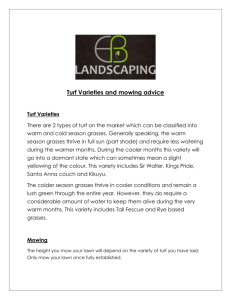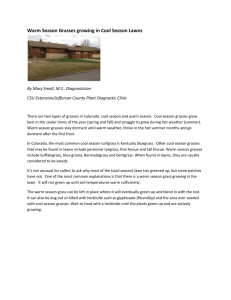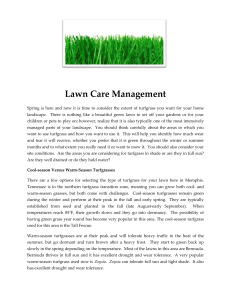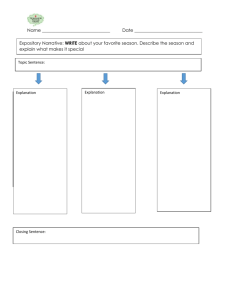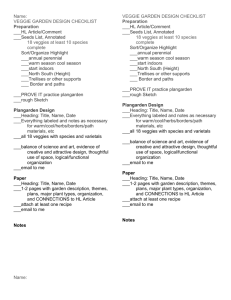Lesson 6: Turf Production and Management
advertisement
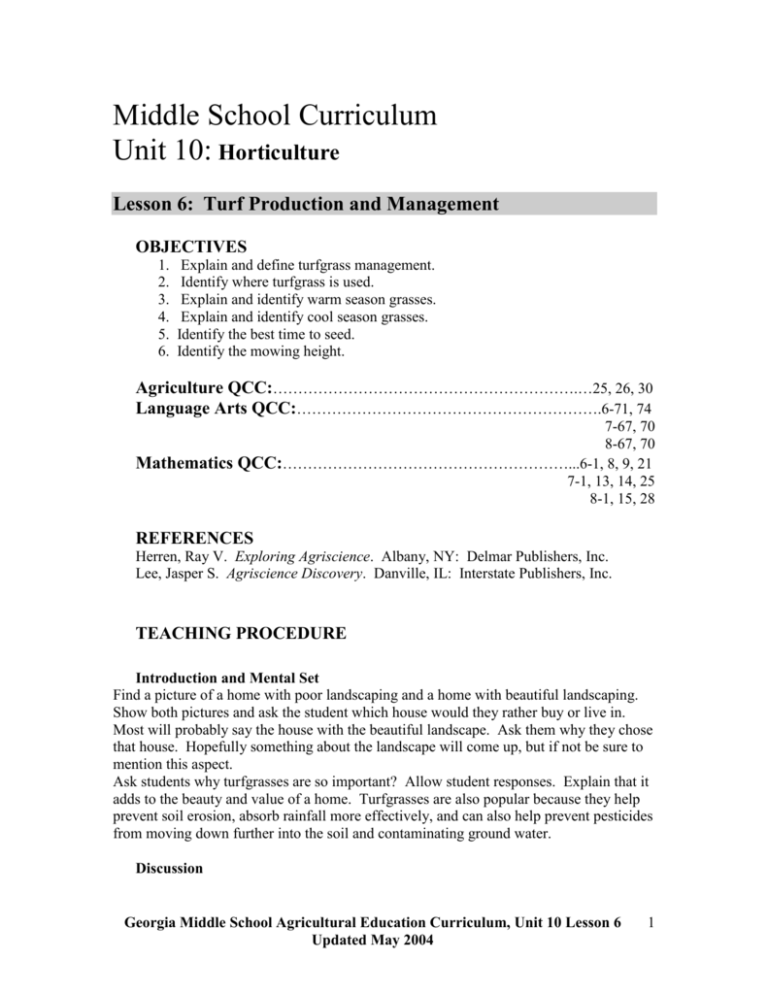
Middle School Curriculum Unit 10: Horticulture Lesson 6: Turf Production and Management OBJECTIVES 1. 2. 3. 4. 5. 6. Explain and define turfgrass management. Identify where turfgrass is used. Explain and identify warm season grasses. Explain and identify cool season grasses. Identify the best time to seed. Identify the mowing height. Agriculture QCC:…………………………………………………….…25, 26, 30 Language Arts QCC:…………………………………………………….6-71, 74 7-67, 70 8-67, 70 Mathematics QCC:…………………………………………………...6-1, 8, 9, 21 7-1, 13, 14, 25 8-1, 15, 28 REFERENCES Herren, Ray V. Exploring Agriscience. Albany, NY: Delmar Publishers, Inc. Lee, Jasper S. Agriscience Discovery. Danville, IL: Interstate Publishers, Inc. TEACHING PROCEDURE Introduction and Mental Set Find a picture of a home with poor landscaping and a home with beautiful landscaping. Show both pictures and ask the student which house would they rather buy or live in. Most will probably say the house with the beautiful landscape. Ask them why they chose that house. Hopefully something about the landscape will come up, but if not be sure to mention this aspect. Ask students why turfgrasses are so important? Allow student responses. Explain that it adds to the beauty and value of a home. Turfgrasses are also popular because they help prevent soil erosion, absorb rainfall more effectively, and can also help prevent pesticides from moving down further into the soil and contaminating ground water. Discussion Georgia Middle School Agricultural Education Curriculum, Unit 10 Lesson 6 Updated May 2004 1 1. What is turfgrass management? Turfgrass management is a range of activities that help establish and sustain turf at a desired level of quality. 2. What are some ways of mismanaging turfgrass? Mismanagement can occur as a result of poorly adapted turfgrass; improper establishment; errors in mowing, fertilization, and irrigation; improper cultivation; mistakes in pesticide selection. 3. What are some ways in which turf is used? Turfgrass is an outstanding ground cover for athletic fields because it can recover quickly after injury and because it allows for a soft surface. Turfgrass is also widely used on golf courses. Parks, cemeteries, and highway sides also use turfgrass. 4. What are warm season turfgrasses? Give examples. Most warm season turfgrasses are adapted to the southern United States. These grasses grow best at temperatures of 80 degrees F. or higher. These grasses cannot tolerate cold temperatures very well. -Pass out Handout #1 so students can see where warm season turfgrasses are used. A. Examples include: Pass out Handout #2 to show pictures of grass. Bermudagrass, St. Augustinegrass, Bahiagrass, Seasshore pespalum, Centipedegrass, Zoysiagrass, Japanede Lawngrass, Mascarenegrass, Manilagrass, Common carpetgrass, Dichondra, Kikuyugrass, Buffalograss, Blue Grama. 5. What are cool season turfgrasses? Give examples. Most cool season grasses are adapted to the northern United States. These grasses grow best in temperatures of 60-75 degrees F. Heat tolerance for these plants is poor. Some cool season grasses can be grown in the transition zone. -Pass out Handout #1 so students can see where cool season turfgrasses are used. B. Examples include: Pass out Handout #3 to show pictures of grass. Kentucky bluegrass, Rough bluegrass, Canada bluegrass, Annual bluegrass, Poa supine, Perennial ryegrass, Annual ryegrass, Intermediate ryegrass, Creeping bentgrass, Colonial bentgrass, Velvet bentgrass, Redtop, Tall fescue, etc. 6. When is the best time to seed? The favored time for seeding cool season turfgrasses is in late summer. These times are late August and September in the north and late September into October in the south. Seeding in the spring is not desirable. The favored time for seeding warm season turfgrasses is in late spring or early summer. 7. What is the appropriate amount of grass to be cut at each mowing and how often should it be cut? No more than 1/3 of the leaf growth should be removed at each mowing. Mowing should not be determined when it is most convenient (example Georgia Middle School Agricultural Education Curriculum, Unit 10 Lesson 6 Updated May 2004 2 every Saturday). Mowing depends on the growth rate and remember that no more than 1/3 of the leaf blade should be cut at one mowing. Activities: Visit the football field or local golf course to observe the different types of turf used and the different mowing heights of the grass. You can also go on a grass hunt around the school. Decide what grasses you would like to find and hunt for them. Allow students to grow different pots of turfgrass. Some warm season and cool season. Allow them to observe and see how different temperatures affect them. Georgia Middle School Agricultural Education Curriculum, Unit 10 Lesson 6 Updated May 2004 3 ACADEMIC CONNECTIONS Mathematics Middle School Connections in Agriculture Education Mathematics QCC: Grade 6- 1, 8, 9, 21 7- 1, 13, 14, 25 8- 1, 15, 28 Name____________________________________ Period____ Date______________ Complete the following problems: Remember that you learned that no more than 1/3 of leaf growth should be removed at each mowing. 1. If your grass height is 6 inches how much growth should be removed during mowing if you are removing 1/3 leaf growth? 2. If your grass height is 12 inches how much growth should be removed during the mowing if you are removing 1/3 leaf growth? 3. If you have removed 10 inches of leaf growth after mowing, what was the original grass height (remember you removed 1/3 leaf growth)? 4. Kentucky bluegrass is considered a cool season grass. Since cool season grasses grow best in temperatures ranging between 60-75 degrees F, could a cool season grass grow well at 20 degrees C.? *Fahrenheit to Centigrade: C = (F – 32) 5/9 *Centigrade to Fahrenheit: F = (9/5 C) + 32 5. Bermudagrass is considered a warm season grass. Since warm season grasses grow best in temperatures ranging between 80 degrees F. or higher, determine the degrees C. that it would grow best in? Georgia Middle School Agricultural Education Curriculum, Unit 10 Lesson 6 Updated May 2004 4 Answers: 1. 2 inches 2. 4 inches 3. 30 inches 4. yes; because F = (9/5 C) + 32 so (9/5 x 20) + 32 = 68 degrees F. 5. 26.66 or 26.7 degrees C. or higher; because C = (F-32) 5/9 so (80-32) 5/9 = 26.666 Georgia Middle School Agricultural Education Curriculum, Unit 10 Lesson 6 Updated May 2004 5 ACADEMIC CONNECTIONS Mathematics Middle School Connections in Agriculture Education Mathematics QCC: Grade 6- 21 7- 25 8- 28 Name____________________________________ Period____ Date______________ Part of turf management includes keeping the grass cut. Below are some word problems associated with cutting grass. 1. A riding mower takes only 1 minute to cut 1,000 square feet; how many minutes will it take to cut 18,000 square feet? 2. How many hours will it take Jason to cut 15, 560 square feet with a push mower if it takes him 5 minutes to cut 1,000 square feet? 3. Lindsay cuts grass on the average of 22 times a year. If it takes her an hour and half to cut grass each time, how much money will she make if her father pays her $3.75/hour (round to two decimal places)? 4. Determine the cost of mowing 10,000 square feet of grass with a 20-inch push mower if it takes 7 minutes to cut 1,000 square feet. Labor costs $3.50/hour. Georgia Middle School Agricultural Education Curriculum, Unit 10 Lesson 6 Updated May 2004 6 Answers: 1. 18 minutes. 1 minute = x minutes 1000 feet 18,000 feet so 1000x = 18,000 divide 18,000 by 1000 = 18 2. 1.3 hours 5 minutes = x minutes 1000 feet 15,560 feet so 1000x=77,800 divide 77,800 by 1000 = 77.8 77.8 minutes, need in hours so divide by 60 = 1.3 hours. 3. $123.86; $3.75 x 1.5 hours = $5.63 each time she cuts grass. $5.63 x 22 = $123.75 total. 4. $4.20; 7 minutes = x minutes 1000 feet 10,000 so 1000x = 70,000 divide 70,000 by 1000 = 70 70 minutes, need in hours so divide by 60 = 1.2 hours; now 1.2 hours x $3.50 = $4.20 Georgia Middle School Agricultural Education Curriculum, Unit 10 Lesson 6 Updated May 2004 7 ACADEMIC CONNECTIONS Language Arts Middle School Connections in Agriculture Education Language Arts QCC: Grade 6-71, 74 7-67, 70 8-67, 70 Name____________________________________ Period____ Date______________ Imagine that you have a friend living in Alaska. The two of you send letters back and forth to one another. Your friend loves reading about the things you learn at school, especially in your agriculture class. Write a letter to your friend and tell him or her what you have learned about turfgrass. Include descriptions of types of grasses, management, uses, and seasons. Remember the letter writing skills you learned in Language Arts class. ________________________________________________ ________________________________________________ ________________________________________________ ________________________________________________ ________________________________________________ ________________________________________________ ________________________________________________ ________________________________________________ ________________________________________________ ________________________________________________ ________________________________________________ ________________________________________________ ________________________________________________ ________________________________________________ ________________________________________________ ________________________________________________ ________________________________________________ ________________________________________________ ________________________________________________ ________________________________________________ Georgia Middle School Agricultural Education Curriculum, Unit 10 Lesson 6 Updated May 2004 8 SUMMARY Students will learn about turfgrass management, where turfgrass is most often used, what are warm season turfgrasses, what are cool season turfgrasses, when to seed and how much leaf growth to remove when mowing. Evaluation Written Quiz Georgia Middle School Agricultural Education Curriculum, Unit 10 Lesson 6 Updated May 2004 9 Handout #1: Temperature Zones A. B. C. D. E. Cool Humid Transition Zone Warm Humid Cool Arid Warm Arid Regions A and D experience colder temperatures and are most suitable for cold season grasses. Region A and D are called cool season zone. Regions C and E experience warmer temperatures and are most suitable for warm season grasses. Region C and E are called warm season zone. Region B is known as the transition zone. Georgia Middle School Agricultural Education Curriculum, Unit 10 Lesson 6 Updated May 2004 10 Handout #2 Warm season grasses. Bermudagrass Bahiagrass St. Augustinegrass Centipedegrass Zoysiagrass Georgia Middle School Agricultural Education Curriculum, Unit 10 Lesson 6 Updated May 2004 11 Handout #3: Cool Season Trufgrasses Kentucky Bluegrass Tall Fescue Perennial Ryegrass Creeping Bentgrass Georgia Middle School Agricultural Education Curriculum, Unit 10 Lesson 6 Updated May 2004 12

